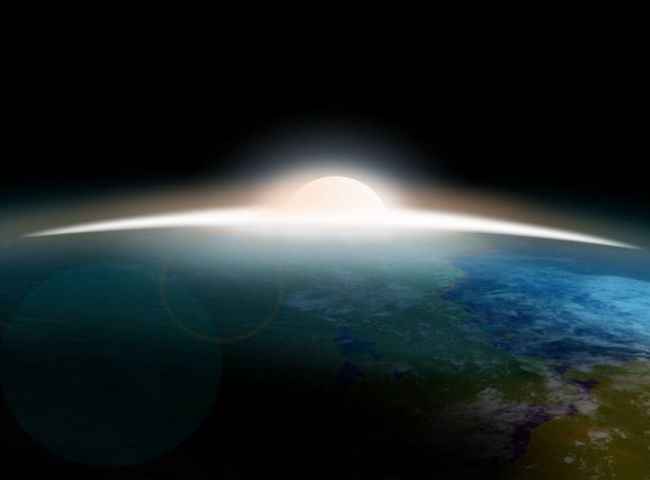
Microorganisms embedded in fragments of distant planets that crashed to Earth might have been seeds of life on our planet, U.S. and European researchers say.
Scientists from Princeton University, the University of Arizona and the Centro de Astrobiologia in Spain, writing in the journal Astrobiology, said there is a possibility that life came to Earth -- or spread from Earth to other planets -- during the solar system's infancy when Earth and planetary neighbors orbiting other stars would have been close enough to each other to exchange lots of solid material.
The scientists said their research provides support for "lithopanspermia," the idea basic life forms are distributed throughout the universe via meteorite-like planetary fragments cast forth by disruptions such as volcanic eruptions and collisions with other matter.
Eventually, another planetary system's gravity traps these roaming rocks, which can result in a mingling that transfers any living cargo, they said.
Lithopanspermia could happen under a process called weak transfer wherein solid materials meander out of the orbit of one large object and happen into the orbit of another, a Princeton release reported.
Our solar system and its nearest planetary-system neighbor could have swapped rocks at least 100 trillion times well before the sun journeyed away from its native star cluster, the researchers said.
"If this mechanism is true, it has implications for life in the universe as a whole," lead study author Edward Belbruno said.
"This could have happened anywhere." (UPI)
<관련 한글 기사>
“최초의 생명, ‘외계행성’에서 왔을수도”
지구상에 처음 생명체가 나타나게 된 계기가 태양계 바깥의 행성에서 지구로 옮겨온 미생물이라는 연구결과가 나왔다.
미국 프린스턴 대학, 애리조나 대학과 스페인의 우주 생물학 센터 (Centro de astrobiologia)가 공동으로 진행한 연구에 따르면 태양계가 처음으로 생성되었을 당시, 태양계의 행성들과 인근에 있었던 다른 항성 주변을 공전하던 행성들이 서로 물질을 교환했을 가능성이 있다고 한다.
연구진은 자신들의 연구가 리토판스퍼미아 (lithopanspermia: 외계생명체 유입설)라는 가설을 뒷받침한다고 주장했다. 리토판스퍼미아는 화산폭발이나 외부 물체와의 충돌 등으로 인해 운석 형태의 조각들이 하나의 행성에서 다른 행성으로 옮겨가는 과정을 통해 생명체가 전파되었다고 주장하는 이론이다.
이렇게 하나의 행성에서 분출된 운석들은 다른 행성계의 중력에 끌려오게 되고, 운석과 함께 미생물도 이동하게 되는 것이다. 그 외에 “약한 이동(weak transfer)”이라는 과정을 통해서도 이동이 일어나는데, 이는 한 행성 등 대형 물체의 주변을 공전하던 작은 물체가 궤도에서 벗어나 다른 대형 물체의 주변을 공전하게 되는 경우를 일컫는다.
연구진은 태양과 다른 항성이 서로 멀어지기 전까지 두 항성 주위를 돌던 행성들이 최소 100조번 정도 운석 등을 교환했을 수 있다고 설명했다.
“만약 이 가설이 사실이라면 우주 전체에 걸쳐 생명이 존재할 수 있다는 것을 암시합니다”라고 연구를 주도한 에드워드 벨브루노는 말했다. “이러한 과정은 어디에서든 일어날 수 있으니까요”
이 연구는 과학 저널 “우주생물학 (Astrobiology)”에 실렸다.








![[Graphic News] More Koreans say they plan long-distance trips this year](http://res.heraldm.com/phpwas/restmb_idxmake.php?idx=644&simg=/content/image/2024/04/17/20240417050828_0.gif&u=)
![[KH Explains] Hyundai's full hybrid edge to pay off amid slow transition to pure EVs](http://res.heraldm.com/phpwas/restmb_idxmake.php?idx=644&simg=/content/image/2024/04/18/20240418050645_0.jpg&u=20240419100350)





![[From the Scene] Monks, Buddhists hail return of remains of Buddhas](http://res.heraldm.com/phpwas/restmb_idxmake.php?idx=652&simg=/content/image/2024/04/19/20240419050617_0.jpg&u=20240419175937)

![[KH Explains] Hyundai's full hybrid edge to pay off amid slow transition to pure EVs](http://res.heraldm.com/phpwas/restmb_idxmake.php?idx=652&simg=/content/image/2024/04/18/20240418050645_0.jpg&u=20240419100350)

![[Today’s K-pop] Illit drops debut single remix](http://res.heraldm.com/phpwas/restmb_idxmake.php?idx=642&simg=/content/image/2024/04/19/20240419050612_0.jpg&u=)